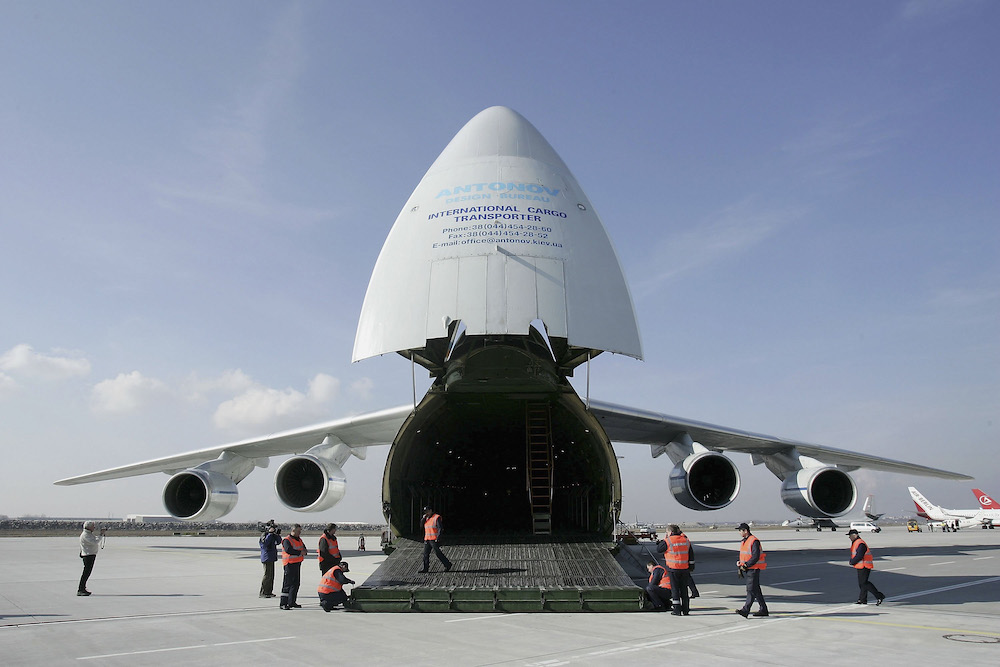Giant cargo jets sidelined by Russia’s invasion of Ukraine
Russia’s invasion of Ukraine has sidelined a fleet of massive air freighters that oil companies and engineering firms rely on to carry oversize items such as helicopters, power turbines and are even used for spacecraft.
The Antonov An-124 was once a symbol of cooperation between the two countries—designed in Ukraine and used by Russia’s Volga-Dnepr Group for missions ranging from transporting Boeing Co. aircraft parts to providing disaster aid in Puerto Rico.
Volga-Dnepr’s fleet of 12 An-124s is now hemmed in by sanctions, while others in Ukraine are caught up in the war itself.

With a nose that lifts to create an opening 21 feet wide by almost 15 feet high, the An-124 fills a lucrative niche in the $175 billion global air-cargo sector. Its capacity of 150 tons makes it a favorite of oil producers and engineering firms moving pipes, drills and power generation equipment.
“No other aircraft can perform the role of the An-124 and if these aircraft are out of commission there’s going to be a real shortage of heavy lift capability that will impact pricing and ultimately the ability of companies to move certain shipments,” said Dan Morgan-Evans, cargo director at Air Charter Service, a U.K.-based broker that regularly books An-124 flights for clients.
The sole Antonov An-225, a larger six-engine variant designed to carry the Soviet Union’s abortive space shuttle, is already reported damaged beyond repair in a battle for Hostomel airport outside Kyiv. It ranked as the biggest plane flying.
Morgan-Evans said that managers at Antonov Airlines, which operated the An-225 and has seven An-124s, told him the Ukrainian company’s commercial premises have been destroyed. An unknown number of the planes were on missions elsewhere and appear to have escaped the conflict.
Strained Venture
Antonov ended its decade-long An-124 joint venture with Volga-Dnepr in 2016, amid higher tensions between the two countries following Russia’s invasion of Crimea.
Volga-Dnepr’s scope for operations is now severely limited as more countries close their airspace to Moscow in response to last week’s invasion. In the run-up to sanctions, it removed all of its aircraft from the EU, the online publication The Loadstar reported. One An-124 remained grounded at Pearson Airport in Toronto, after Canada closed its airspace to Russian registered aircraft, the Associated Press reported.
The threat to the An-124—known as the Ruslan or Lion in Ukrainian—comes at a time when rising crude prices are expected to spur investment in oil and gas fields and hence demand for the planes, Morgan-Evans said.
The planes’ absence also exacerbates a broader squeeze on supply chains that has helped fuel inflation globally since the start of the Covid-19 crisis. Sanctions will lead to longer flight times, higher fuel consumption and increased emissions as traffic is rerouted around Russia, according to logistics firm Flexport, with energy companies bearing the biggest direct impact from the disruptions.
Workaround Options
While Boeing 747 freighters also feature a nose door, giving them some outsize capability, they are not as big, and the An-124 has the unique ability to “kneel” by lowering its forward landing gear. This allows wheeled or tracked vehicles to be driven directly aboard via an extendable ramp.
The aircraft can also be loaded from the tail and features electric winches able to haul three tons in weight and four electric hoists that can carry 30 tons.
European planemaker Airbus SE recently entered the outsize freight market, with plans to use its massive Beluga jets to transport products such as helicopters, boats or trucks for customers.
The planes, modified from the A300 wide-body platform, have been used internally to carry wings between its plants. With a newer, larger batch of Belugas coming into service, the Toulouse, France-based company will shift two older BelugaST planes to the new freight operation this year, ramping up to five by 2024.
It’s too early to draw any conclusions on what the current situation in Russia and Ukraine will mean for Beluga demand, an Airbus spokesman said
According to an Airbus presentation on the project, the BelugaST is slightly shorter than the An-124 at 39 meters versus 41 for the Russian jet, but is taller and wider.
Similar Stories

Inauguration of the Fly’in technology center: Daher paves the way for the future of decarbonized aviation
View ArticleHorizon Aircraft signs Letter of Intent with Discovery Air Chile Ltda., expanding global presence of Cavorite X7 Hybrid eVTOLs
New Horizon Aircraft Ltd. (NASDAQ: HOVR), doing business as Horizon Aircraft (“Horizon Aircraft” or the “Company”), a leading hybrid electric Vertical Take-Off and Landing (“eVTOL”) aircraft developer, announced today it…
View Article
WorldACD Weekly Air Cargo Trends (week 1) - 2025
View Article
Lufthansa Cargo exhibiting at Fruit Logistica 2025
View Article
A flying start to 2025 but after 14 months of double-digit demand growth, air cargo stakeholders remain cautious
View ArticlePharma.Aero expands global network with six key new members
CEVA Logistics, Skandi Network, SCL Cold Chain, Shipex NV, Pharming Group, and ARTBIO join the life sciences logistics collaborative platform
View ArticleGet the most up-to-date trending news!
SubscribeIndustry updates and weekly newsletter direct to your inbox!





